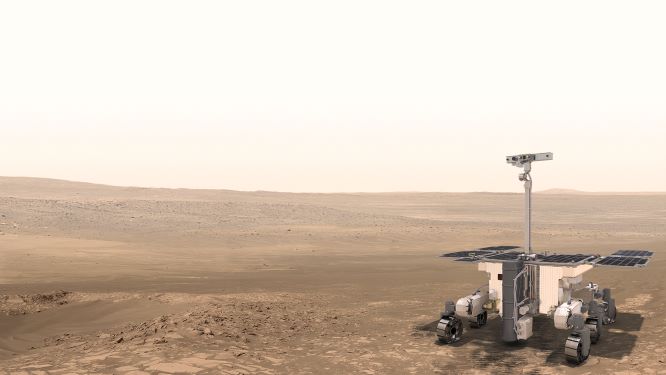Sunlight sensing: Artist’s impression of the ExoMars Trace Gas Orbiter (TGO) analysing the Martian atmosphere (Courtesy: ESA)”>
Scientists in Russia have observed trace amounts of hydrogen chloride in Mars’ atmosphere for the first time. The detection, which was based on data from the ExoMars Trace Gas Orbiter (TGO), raises questions about the dynamics and chemistry of the Martian atmosphere and surface as well as the processes that could have formed the compound.
At local sunrise and sunset, two of the instruments aboard the TGO – the Nadir and Occultation for Mars Discovery (NOMAD) and the Atmospheric Chemistry Suite (ACS) – use spectrometers to analyse the sunlight that passes through the Martian atmosphere. These sensitive instruments make it possible to detect trace species at the parts-per-billion (ppb) level.
Dusty discovery
The TGO picked up the first signs of hydrogen chloride (HCl) shortly after a global dust storm (GDS) that occurred in Martian year 34 (MY34), equivalent to 2018 on Earth. These storms occur every 3–4 Martian years on average, when the planet’s complex orbital pattern ensures that summer in its southern hemisphere coincides with the point at which it is closest to the Sun (perihelion).
The researchers, who report their work in Science Advances, suggest that the appearance of the HCl could be due to water vapour interacting with chlorine from the dust grains. “Both dust and water vapour in the atmosphere are amplified during GDS or ‘dusty season’,” explains Oleg Korablev, who led the research at the Space Research Institute of the Russian Academy of Sciences.
Even without a GDS, however, Korablev notes that Mars’ atmosphere tends to become dustier at perihelion due to an increase in the planet’s atmospheric circulation intensity. Indeed, a separate study led by K S Olsen recently found that HCl reappeared in Mars’ atmosphere in the dusty season of the following year, MY35, when there was no GDS.
Volcanic alternative
Korablev and colleagues also put forward an alternative hypothesis for the formation of HCl in Mars’ atmosphere: the compound could be released directly from volcanoes. This possibility would be analogous to volcanic activity exhibited on Earth, where chlorine compounds and their reactions with aerosols are known to impact the ozone layer in the stratosphere.
However, the scientists say that this hypothesis is less likely because it would be hard to explain how a localized surface source could produce such widespread atmospheric traces of HCl. In addition, seismic data from a separate Mars mission, NASA’s InSight Lander, indicates that Mars does not experience much volcanic activity, and the TGO did not detect the abundance of sulphur gas that a volcanic eruption would produce.
Joint exploration
Korablev says that further research on the chemical cycles of elements such as nitrogen and sulphur will be needed to characterize the processes taking place on Mars. In particular, scientists have not yet confirmed and quantified the gas-solid heterogeneous reaction that might allow chlorine salts in the Martian dust to join up with atmospheric water vapour to form HCl gas. An explanation for why the HCl gas disappears after the end of the dusty season is also lacking.

Mars rover launch delayed until 2022
While the TGO is a collaborative project between the European Space Agency (ESA) and the Russian Roscosmos State Space Cooperation, Korablev points out that the upcoming ExoMars 2022 mission is more complex, with the success of the “mostly ESA” Rosalind Franklin rover depending on “intertwined” subsystems of the landing module. Like NASA’s just-landed Perseverance rover, ExoMars 2022 aims to understand Mars’ astrobiological and geological processes, as well as the history of Martian water. A key component will be the Franklin rover’s onboard spectrometer, the NASA-provided Mars Organic Molecule Analyzer, which will perform the first analyses of the amount and type of chemicals in the Martian subsurface – potentially confirming theories of the planet’s formation. Getting all these parts to work together will be a challenge, Korablev says; nonetheless, he thinks “the agencies will learn the lesson” and that “joint is good”.
